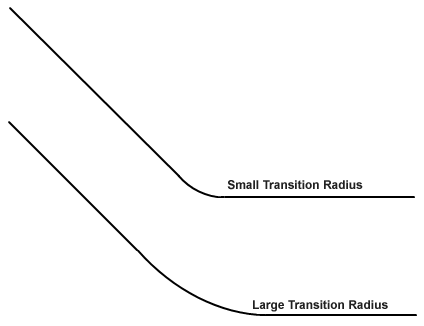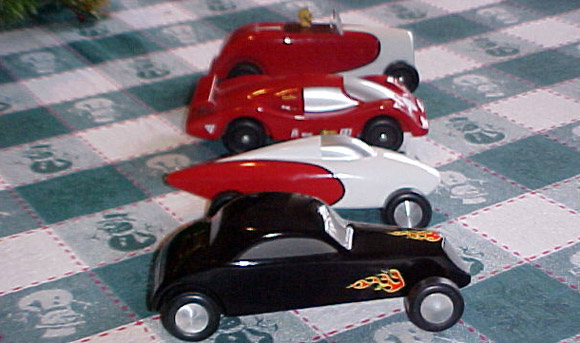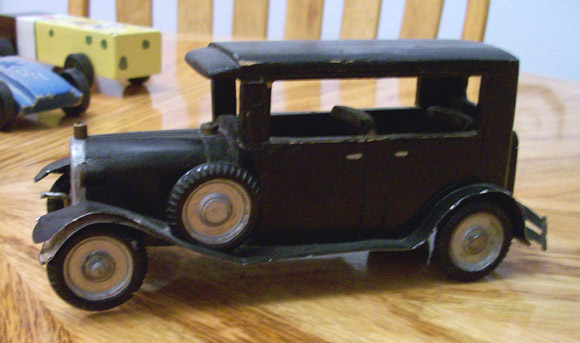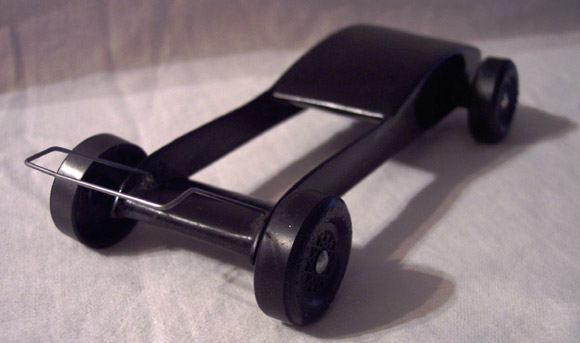– Feature Article – Effect of Track Configuration on Car Performance
– Pinewood Derby Car Showcase
– Memory – Yes, Sir, That’s my Derby
– Q&A
Effect of Track Configuration on Car Performance
I have often been asked about the specifications of the ‘official’ pinewood derby track. A standard length, a standard height, a standard radius for the transition: if it were only so.
As you likely know, there is not one standard for pinewood derby tracks, so manufacturers are free to offer their own design. And of course, “do-it-yourselfers” build tracks based on existing plans, or their own conception. All of this leads to tracks of varying lengths, heights, transitions (some with no transition), and surface materials.
With this wide variety of racing conditions, the question for car builders is, “For a given track configuration, what car design elements will produce the best results?” This is actually quite a broad question, and thus cannot be fully answered in this brief article. However, I will provide some basic design considerations when confronting various track configurations. To simplify matters I will assume a center-guide track with an initial slope, a curved transition, followed by a flat section.1
Center of Gravity
Before discussing track configurations, a brief review of the Center of Gravity (COG) is appropriate. The COG is the point at which the completed car balances front-to-back. A COG further back on the car will produce more speed, but will sacrifice some stability. A COG of 1 to 1-1/4 inches in front of the rear axle is appropriate for most tracks. A more aggressive COG (closer to the rear axle) can achieve better results under optimum track conditions, while a more conservative COG (further from the rear axle) is more appropriate for adverse conditions. With this in mind, let’s discuss tracks.
Height Of Starting Gate
The height of the starting gate from the floor dictates the amount of potential energy that is available to the car. Thus, a higher starting gate will produce higher speeds, which in turn require more stable cars. The starting gate of most tracks is approximately 4 feet. At this height, no special consideration is required. However, if you will be running on a track with a higher starting gate, then a less aggressive COG may be required if warranted by other track factors.
Transition Radius
A large transition radius (see Figure 1) is slightly more ‘gentle’ on cars, thus allowing a more aggressive configuration. On the other hand the front end of cars equipped with a very aggressive COG will tend to lift slightly when negotiating a small transition radius. Most of the manufacturers offer a large transition radius, while one manufacturer offers a slightly smaller transition radius.2

Transition Radius Comparison
Track Length
Longer tracks have a longer horizontal run-out, thus providing more opportunity for cars to slow down before reaching the finish line. To maintain momentum on longer tracks, cars must be at maximum weight, have good aerodynamics, and must be as frictionless as possible. In addition, a less aggressive COG will generally provide better results, as the frictional forces will be more evenly divided among the wheels.
Track Surface
Smooth track surfaces produce faster results and allow for more aggressive car configurations. Thus, on smooth tracks, the COG can be moved further to the rear of the car. Rougher tracks require a more stable configuration with a COG closer to the center of the car.
Track Tilt
Tracks should be virtually level side-to-side. However, it is of course impossible to achieve a perfectly level state, so all tracks will exhibit some amount of side-to-side tilt. This results in cars moving towards the lower side until the guide rail is encountered.
The fastest times will be achieved when the amount of guide rail contact is minimized. However, recognizing that some guide rail contact will occur, and that the side-to-side tilt of the track cannot be predicted, is there any advantage to purposely ‘steering’ the car left or right? Some anecdotal evidence indicates that if the car is equipped with a raised front wheel (the car runs on three wheels), then it is best to minimize contact with the raised wheel.3 To accomplish this, the car can be aligned to purposely ‘steer’ towards the side of the car on which the raised wheel is mounted. This eliminates any contact between the guide rail and the raised wheel, possibly increasing performance.
Practical Considerations
- Each track has its own performance characteristics. This article discusses general design considerations based on track configuration, however, to accurately ascertain the performance characteristics of a given track, tests must be run on that specific track.
- Sometimes the track configuration at a local event and the subsequent district event are quite different. In this case, consider designing the car with adjustable weight so that the COG can be changed between events.
- Regardless of the track, smooth and round wheels, polished axles, good lubrication, and good alignment will overcome many obstacles.
1All of the commercial track manufacturers produce a track with these design features, except for one (SuperTimer) which has side guides.
2The original BestTrack transition was quite small, however, that was replaced several years ago with a larger radius.
3One advantage to a raised wheel is that it does not have to spin while the car is accelerating. However, if the raised wheel contacts the guide rail, it will be spun-up, thus robbing some energy from the car.
Pinewood Derby Car Showcase
Show Cars: Joe Burns
I was at my in-law’s house over the holidays, and their neighbor came over and asked if I wanted to see his son’s pinewood derby cars. This neighbor works in a body shop and it shows. The cars have an unbelievable amount of detail – the pictures don’t do the cars justice. They built all these from scratch without kits like they have today.
Model T: Duane Rubink
This car was built by my dad and me about 34 years ago; it’s my pride and joy. My dad is such a talented woodworker. I remember this car ran just like an old model T, shaky and slow, but what a looker! It’s pretty old and beat up now, but it is of great value to me.
It’s Fast!: John Phillips
I made this car for last year’s races. The side rails are 1/32 inch aircraft plywood, with a wire starting bar. I don’t really have a name for the car but it is fast!
Pinewood Derby Memory
Yes, Sir, That’s my Derby
Whenever I hear about a childhood competition, it brings back memories of the contests I took part in as a youth – memories of everything from slightly embarrassing mishaps, like going back for a catch in centerfield and tumbling head-over-heels like Clouseau going over a couch, to those really earth-shattering failures I’d rather not elaborate on here.
The reason I bring this up is because several scout troops on the North Shore held their annual Pinewood Derbies this past weekend. This is not to be confused with the Soap Box Derby, in which small children are placed into wooden boxes and sent hurtling down a hill toward a pile of none-too-comforting bales of hay. (I recall asking my mother if I could participate in one of these, and she was diplomatic, answering, “Not while I have breath left in my lungs.”)
No, the Pinewood Derby is the event in which you are issued a block of wood and four plastic wheels and asked to turn it into something aerodynamically suitable for racing – the “you” in most cases being, of course, your father. My particular father has a long history of “helping” us with various projects and assignments, and if I’m not mistaken is still smarting over the C+ my “sister” received on a 10th grade English essay.
Anyway, in this instance – my first year as a Cub Scout – we divided up the car-building chores, my father handling carving the wood and attaching the plastic wheels, while I, working painstakingly well into the night, picked the color. (Red.)
As far as the specifics of our model, my father and I decided to concentrate on function over form – specifically, on weight. Back then there were no limits to how much your car could weigh, so we dug out a good portion of the front of the car and filled it with lead fishing weights, and covered the consequent hole with a large, metal plate. The result was an 8-by-2-inch car whose nose weighed more than my brother.
And soon it was time to put it to the test. The big race was held in conjunction with our summer barbecue at our local county park, which was one of those parks you find in New York with a murky lake and a man-made beach; if you dug down far enough through the sand with your little shovel you would actually hit the plastic lining.
The race was supposed to take place after swim time, but as I approached the race area, eating a hot dog and picking seaweed (lakeweed?) off myself, I noticed the medals had already been awarded – and next to my car was a big, fat empty space. Of course, next to Billy Enderlee’s car was a gold medal.
My initial thought was that they’d run the races without us present, sparing me the indignity of watching myself lose to Billy, who’d had it in for me ever since I accidentally thwocked him in the head with a ball during baseball practice. But as they gathered us together, it became clear that those initial medals were just for presentation – which made sense, as Billy’s car had been meticulously carved into the shape of an alligator more sophisticated than any 8-year-old could even visualize, much less execute. It was the envy of every father there.
So my heart pounded in my chest as the true test of our wooden creations began. I watched as the scoutmaster put my car on the starting line and flicked the switch letting the cars loose. It hung in the air for a second, as if hesitating momentarily – and then whipped down the track like a bobsled slathered in baby oil.
The other fathers’ cars never knew what hit them.
My car progressed through the heats, beating the James Bond car, the Starsky & Hutch car, the car made to look like a stegosaurus (a notoriously slow dinosaur, incidentally), until only mine and Billy Enderlee’s alligator special remained. My father tried to remain calm, but he had that same look on his face he used to get on those rare occasions in the fourth quarter when it looked like the Giants might actually win a game. (I should mention that the Giants and I had about the same winning percentage at everything we tried during most of the 1970s.)
I remember that last heat distinctly; the alligator took off like a shot, my square red model tailing it ever-so-slightly. The whole course was negotiable in about 12 seconds, but time stood still as they shot down the track. The crowd stood silent. A bead of sweat appeared on my father’s forehead. My stomach rumbled, and I realized I hadn’t finished my hot dog.
And then, as my dragster inched its lead-weighted nose past the alligator to cross the finish line, the crowd exploded. Well, maybe it didn’t explode, but it seemed pleased.
My father stood beside me proudly as I was issued my medal, although both of us wondered later why the pack couldn’t have just sprung for a trophy. Regardless, we savored the moment, not realizing at the time it would be the first in a very short line of competitive accolades I would earn, capped off five years later with my “Most Improved Bowler” trophy.
I felt a little bad for Billy Enderlee, though, and even unofficially raced him a few times afterward until he finally beat me – by turning the alligator around and sending it down the track backwards. Too much weight in the tail; how many of us have been found ourselves undone by the same predicament?
Anyway, I hope the local scouts enjoyed their respective derbies last weekend, and realized, like I did, that it’s not about winning, but about doing your best. Or about your father doing his best. One of those two things.
Although, as I think my dad would attest, winning is not bad either.
Copyright ©2003 Peter Chianca
Reprinted by permission
Q&A
Our pack has switched from the BSA kits to the PineCar kits with solid axles this year. The explanation was that the nail axles were too difficult for most boys. My son worked hard to prepare his, and has won the pack 2 out 3 years, so we’re disappointed with the decision. Anyway, do you have any ideas on how best to prepare the solid axles? I don’t think we are allowed to cut them. We actually have 2 kits, and on every axle the heads are crooked.
Well, I don’t think your pack made things any easier, as the solid rod axles are not particularly easy to use.
If you can cut the axles in half (check with your race leader), then that would really help, as you can then properly set a wheel to car body gap, and you can mount them in a drill for polishing. If not, then make sure that the block is not too wide. You will likely need to narrow the block so that the wheel to car body gap is correct. When you do this, make sure to account for paint.
I’m not sure what to do about the bent tips. If the hub cap stays on, then they may be fine. But if not, I would try to replace them. You will need to polish the axles. Hopefully you can find a drill with a deep enough chuck so that you can insert the axle and clamp somewhere in the middle. Then polish both ends as you would with nail axle. Just avoid the end – if you reduce the end, then the hub cap may not stay on. You will also want to remove the mold flaw from the hub cap.
For next year, you might let your pack know about our MV Car kits. They use the BSA block, the PineCar wheels, and our speed axles. This is the best of all worlds (and they are less expensive than the PineCar kits). You can find them Here.
Would it help to cover the back of the wheels from the tread to the outer rim of the axle hub with a lightweight yet rigid plastic (adhering the plastic to the wheel of course)? I am thinking that this might reduce drag from the air the open areas catch as the car goes down the track. Do you know if this is in violation of any rules that you have heard?
Interesting idea. First, I don’t know how much aerodynamic loss there is in that area. Second, wheel weight is critical, so you may lose more by the added weight than you would gain by aerodynamics. Then, of course, the race inspectors may think you are hiding something, and want them removed. So, I would get it cleared with the officials before trying it.
When checking for the Center of Gravity, is that done with the wheels on or off?
The center of gravity is checked with the wheels on, and with all added accessories and weight.
Want Answers?
Do you have a pinewood derby-related question? If so, e-mail us your question.We answer all questions by e-mail, but not every question will appear in the Q&A section of the newsletter.
Back Issues
Are you a new subscriber, or have you missed some of the previous newsletters? Don’t miss out; all of the issues for Volume 5 through Volume 17 are posted on our web site.
Newsletter Contributions
We welcome your contributions. If you would like to contribute an article, a web site review, a speed tip, or a pinewood derby memory, please e-mail us.
Subscription Information
The Pinewood Derby Times is a free e-newsletter focused on pinewood derby racing. It is published biweekly from October through March.
If you haven’t already done so, please forward this issue to your pinewood derby friends. But please don’t subscribe your friends. Let them decide for themselves. Thanks.
If this newsletter was forwarded to you, why not subscribe to receive this newsletter. There is no cost, and your e-mail address is safe, as we never sell or share our distribution list.
To subscribe, send a blank e-mail to
pi*********************@*******st.com
You will receive a confirmation e-mail. Reply to the confirmation e-mail and you will start receiving the Pinewood Derby Times with the next issue.
Randy Davis, Editor, Pinewood Derby Times
E-Mail: in**@**************ty.com
(C)2018, Maximum Velocity, Inc. All rights reserved. Please do not reprint or place this newsletter on your web site without explicit permission. However, if you like this newsletter we grant permission, and encourage you to e-mail it to a friend.
Maximum Velocity disclaims any personal loss or liability caused by utilization of any information presented in this newsletter.
The Pinewood Derby Times is not specific to, and is not affiliated with the Boy Scouts of America, YMCA, Awana, or any other organization.
(R)Maximum Velocity is a registered trademark of Maximum Velocity, Inc.
(R)Pinewood Derby is a registered trademarks of the Boys Scouts of America.
(R)Awana is a registered trademark of Awana Clubs International.
All other names are trademarks of their respective owners.



